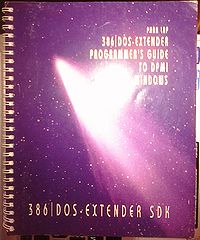Difference between revisions of "386 DOS-Extender"
From Computer History Wiki
(lame initial version) |
m (+cat, +links) |
||
| Line 1: | Line 1: | ||
[[Image:Pharlap-386-Programmers-guide-to-DPMI-and-windows.jpg|thumb|right|200px|Old Manual]] | [[Image:Pharlap-386-Programmers-guide-to-DPMI-and-windows.jpg|thumb|right|200px|Old Manual]] | ||
| − | |||
| − | By using special | + | The '''386|Dos-Extender''' was the first real [[DOS extender|MS-DOS extender]] created by [[Phar Lap]]. |
| + | |||
| + | By using special [[compiler]]s [[Watcom C]] 386, and HighC 386 you could create a 32-bit [[program]] that would run on an unmodified [[MS-DOS]] system equipped with a [[Intel 80386|386]] [[CPU]]. It was significantly easier to deploy 386 extended [[application]]s, however it did carry a significant price tag, compared to deploying [[OS/2 2.0]], although it was much more simpler. | ||
{{stub}} | {{stub}} | ||
| + | |||
| + | [[Category: Operating Environments]] | ||
Revision as of 16:34, 18 December 2018
The 386|Dos-Extender was the first real MS-DOS extender created by Phar Lap.
By using special compilers Watcom C 386, and HighC 386 you could create a 32-bit program that would run on an unmodified MS-DOS system equipped with a 386 CPU. It was significantly easier to deploy 386 extended applications, however it did carry a significant price tag, compared to deploying OS/2 2.0, although it was much more simpler.
